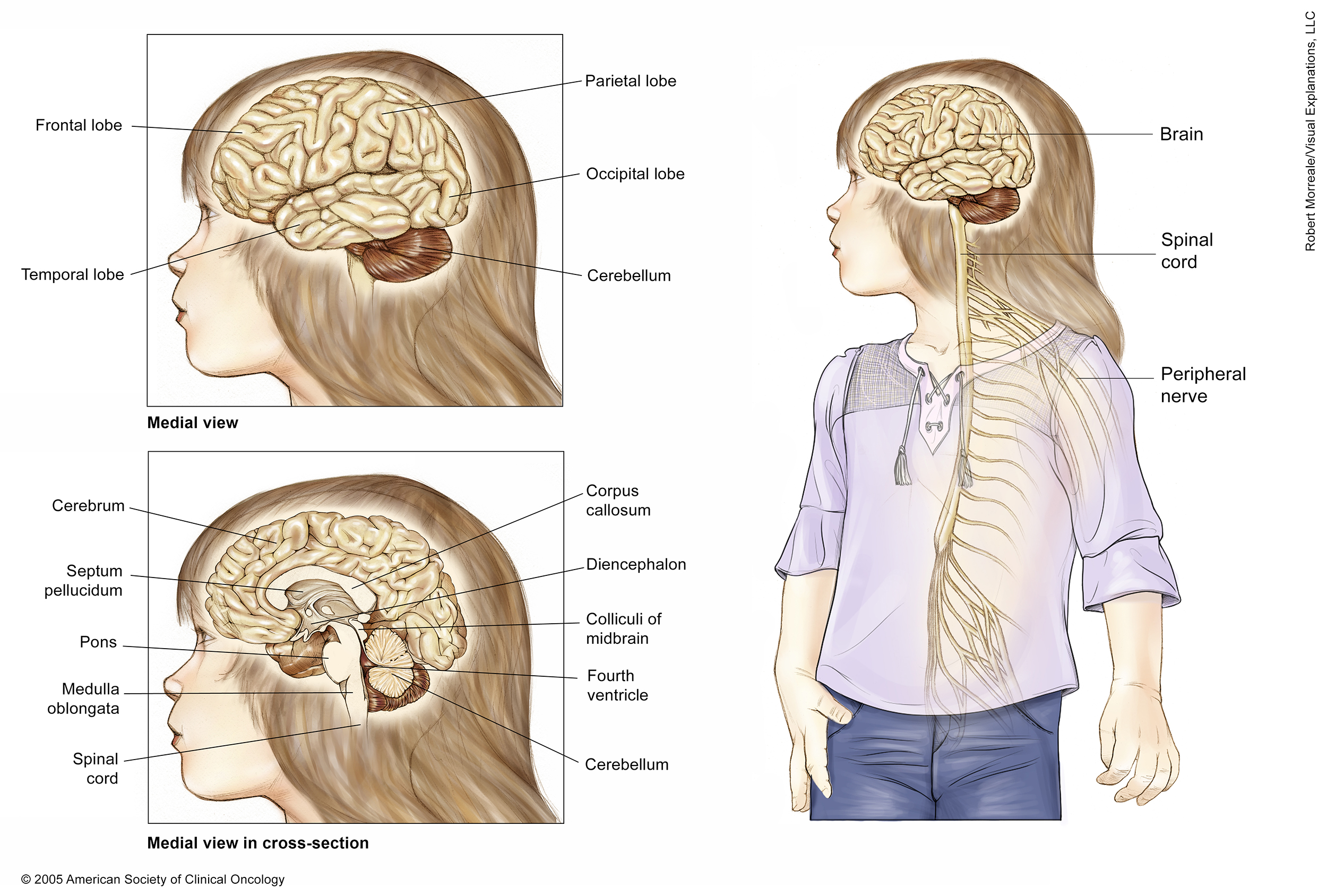ON THIS PAGE: You will find some basic information about this disease and the parts of the body it may affect. This is the first page of Cancer.Net’s Guide to Childhood Central Nervous System Tumors (Brain and Spinal Cord). Use the menu to see other pages. Think of that menu as a roadmap for this entire guide.
About the body's central nervous system
The body's central nervous system (CNS) is made up of the brain and spinal cord.
The brain is the center of thought, memory, and emotion. It controls the 5 senses, which include smell, touch, taste, hearing, and sight. It also controls movement and other basic functions of the body, including heartbeat, circulation, and breathing. The spinal cord consists of nerves that carry information back and forth between the body and the brain.
The brain is made up of 4 major parts:
-
The cerebrum. This is the largest part of the brain. It contains 2 cerebral hemispheres and is divided into 4 lobes where specific functions occur:
-
The frontal lobe controls reasoning, emotions, problem solving, and parts of speech and movement.
-
The parietal lobe controls the sensations of touch, pressure, pain, and temperature.
-
The temporal lobe controls memory and the sense of hearing.
-
The occipital lobe controls vision.
-
The cerebellum. Also called the "little brain," the cerebellum is a part of the brain that is located underneath the cerebrum. It controls coordination and balance.
-
The brain stem. This is the lowest portion of the brain and connects to the spinal cord. It controls involuntary functions essential for life, such as a person’s heartbeat and breathing. Also, nerves that control motor and sensation to the face and swallowing originate within the brain stem.
-
The meninges. These are the membranes that surround and protect the brain and spinal cord. There are 3 meningeal layers, called the dura mater, arachnoid, and pia arachnoid.

When a tumor begins in the CNS
A CNS tumor begins when healthy cells within the brain or spinal cord change and grow out of control, forming a mass. A CNS tumor can be either cancerous or benign. Both types need medical care. A cancerous tumor is malignant, meaning it can grow fast and has the potential to spread to other parts of the brain (and, less often, other parts of the body). A benign tumor means the tumor will often grow more slowly and will not spread to other parts of the body. Even a benign tumor found in the CNS can be problematic because a person’s thought processes and movements may be affected. And, the tissues around the tumor are often vital to the body’s functioning.
The treatment of a CNS tumor in infants and young children may be additionally challenging because a child's brain is still developing and may be affected by the treatment. Doctors consider all of these factors in creating the best treatment plan for each child with a CNS tumor.
Types of CNS tumors in children
In most instances, CNS tumors start from the normal cells of the brain and spinal cord called "neurons" and "glia." Tumors that start from neurons include medulloblastoma and embryonal tumors, such as primitive neuroectodermal tumors (PNET), embryonal tumors with multilayer rosettes (ETMR), and aytpical teratoid/rhabdoid tumors (ATRT). Tumors that start from glia include glioma, astrocytoma, oligodendroglioma, and ependymoma. The tumor's specific name often reflects the CNS tumor's tissue of origin.
In addition to the tumor's name, CNS tumors are described by their grade. This means that each tumor is given a grade on a scale of I to IV (or 1 to 4). Generally speaking, grade I and II tumors are benign; grade III and IV tumors are malignant. The tumor's grade reflects whether the tumor is likely to behave aggressively and whether it is likely to spread to other parts of the brain and spine. Grading is described later in this guide in more detail. There are also specific factors within each tumor type that affect how quickly the tumor will grow. Many of these differences depend on genetic changes found within the tumor (see Diagnosis).
The following types of CNS tumors are most common among children:
This guide covers CNS tumors diagnosed in children and adolescents. Learn more about brain tumors in adults in a separate guide on this website.
Looking for More of an Introduction?
If you would like more of an introduction, explore these related items. Please note that these links will take you to other sections on Cancer.Net:
-
Cancer.Net Patient Education Videos: View a short video led by an American Society of Clinical Oncology (ASCO) expert in brain tumors that provides basic information and areas of research.
-
Cancer.Net en Español: Read about CNS tumors in Spanish. Infórmase sobre tumor del sistema nervioso central en español.
-
Find a Cancer Doctor. Search for a cancer specialist in your local area using this free database of doctors from ASCO.
-
Cancer Terms. Learn what medical phrases and terms used in cancer care and treatment mean.
The next section in this guide is Statistics. It helps explain the number of children and adolescents who are diagnosed with a CNS tumor and general survival rates. Use the menu to choose a different section to read in this guide.
